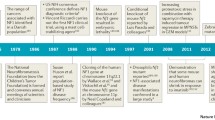Conclusions
It can be stated that the complexity of the mechanisms involved in the pathogenesis of RA requires a multifaceted approach that targets several pathways. Generally, gene targeting should be considered as powerful means to elucidate the pathogenic function of key molecules and, in terms of "functional genomics," to push the development of future therapies.
Similar content being viewed by others
References
Evans CH, Ghivizzani SC, Kang R, et al.: Gene therapy for rheumatic diseases. Arthritis Rheum 1999, 42:1–16.
Berns A: Good news for gene therapy. N Engl J Med 2004, 350:1679–1680.
Crofford LJ: COX-2 in synovial tissues. Osteoarthritis Cartilage 1999, 7:406–408.
Oligino T, Ghivizzani S, Wolfe D, et al.: Intra-rticular delivery of a herpes simplex virus IL-1Ra gene vector reduces inflammation in a rabbit model of arthritis. Gene Ther 1999, 6: 1713–1720.
Kaneda Y, Saeki Y, Morishita R: Gene therapy using HVJ-liposomes: the best of both worlds? Mol Med Today 1999, 5:298–303.
Sullenger BA, Gilboa E: Emerging clinical applications of RNA. Nature 2002, 418:252–258.
Hannon GJ: RNA interference. Nature 2002, 418:244–251.
Evans CH, Robbins PD, Ghivizzani SC, et al.: Clinical trial to assess the safety, feasibility, and efficacy of transferring a potentially anti-arthritic cytokine gene to human joints with rheumatoid arthritis. Hum Gene Ther 1996, 7:1261–1280.
Bresnihan B, Alvaro-Gracia JM, Cobby M, et al.: Treatment of rheumatoid arthritis with recombinant human interleukin-1 receptor antagonist. Arthritis Rheum 1998, 41:2196–2204.
Keystone E, Wherry J, Grint P: IL-10 as a therapeutic strategy in the treatment of rheumatoid arthritis. Rheum Dis Clin North Am 1998, 24:629–639.
Muller-Ladner U, Gay S: The SCID mouse-a novel experimental model for gene therapy in human rheumatoid arthritis. Drugs Today (Barc) 1999, 35:379–388.
Kuiper S, Joosten LA, Bendele AM, et al.: Different roles of tumour necrosis factor alpha and interleukin 1 in murine streptococcal cell wall arthritis. Cytokine 1998, 10:690–702.
Pap T, Franz JK, Hummel KM, et al.: Activation of synovial fibroblasts in rheumatoid arthritis: lack of expression of the tumour suppressor PTEN at sites of invasive growth and destruction. Arthritis Res 2000, 2:59–64.
Firestein GS, Echeverri F, Yeo M, et al.: Somatic mutations in the p53 tumor suppressor gene in rheumatoid arthritis synovium. Proc Natl Acad Sci U S A 1997, 94:10895–10900.
Tak PP, Gerlag DM, Aupperle KR, et al.: Inhibitor of nuclear factor kappaB kinase beta is a key regulator of synovial inflammation. Arthritis Rheum 2001, 44:1897–1907.
Nonomura Y, Kohsaka H, Nasu K, et al.: Suppression of arthritis by forced expression of cyclin-dependent kinase inhibitor p21(Cip1) gene into the joints. Int Immunol 2001, 13:723–731.
Pap T, Nawrath M, Heinrich J, et al.: Cooperation of Ras- and Myc-dependent pathways in regulating the growth and invasiveness of synovial fibroblasts in rheumatoid arthritis. Arthritis Rheum 2004, In press.
Takayanagi H, Juji T, Miyazaki T, et al.: Suppression of arthritic bone destruction by adenovirus-mediated csk gene transfer to synoviocytes and osteoclasts. J Clin Invest 1999, 104:137–146.
Wakisaka S, Suzuki N, Saito N, et al.: Possible correction of abnormal rheumatoid arthritis synovial cell function by jun D transfection in vitro. Arthritis Rheum 1998, 41:470–481.
Rutkauskaite E, Zacharias W, Schedel J, et al.: Ribozymes that inhibit the production of matrix metalloproteinase 1 reduce the invasiveness of rheumatoid arthritis synovial fibroblasts. Arthritis Rheum 2004, 50:1448–1456.
Schedel J, Seemayer CA, Pap T, et al.: Targeting cathepsin L (CL) by specific ribozymes decreases CL protein synthesis and cartilage destruction in rheumatoid arthritis. Gene Ther 2004, 11:1040–1047.
van der Laan WH, Pap T, Ronday HK, et al.: Cartilage degradation and invasion by rheumatoid synovial fibroblasts is inhibited by gene transfer of a cell surface-targeted plasmin inhibitor. Arthritis Rheum 2000, 43:1710–1718.
van der Laan WH, Quax PH, Seemayer CA, et al.: Cartilage degradation and invasion by rheumatoid synovial fibroblasts is inhibited by gene transfer of TIMP-1 and TIMP-3. Gene Ther 2003, 10:234–242.
Hollander AP, Corke KP, Freemont AJ, Lewis CE: Expression of hypoxia-inducible factor 1alpha by macrophages in the rheumatoid synovium: implications for targeting of therapeutic genes to the inflamed joint. Arthritis Rheum 2001, 44:1540–1544.
Shaw MK, Lorens JB, Dhawan A, et al.: Local delivery of interleukin 4 by retrovirus-transduced T lymphocytes ameliorates experimental autoimmune encephalomyelitis. J Exp Med 1997, 185:1711–1714.
Costa GL, Benson JM, Seroogy CM, et al.: Targeting rare populations of murine antigen-specific T lymphocytes by retroviral transduction for potential application in gene therapy for autoimmune disease. J Immunol 2000, 164:3581–3590.
Author information
Authors and Affiliations
Rights and permissions
About this article
Cite this article
Huber, L.C., Pap, T., Müller-Ladner, U. et al. Gene targeting: Roadmap to future therapies. Curr Rheumatol Rep 6, 323–325 (2004). https://doi.org/10.1007/s11926-004-0001-8
Issue Date:
DOI: https://doi.org/10.1007/s11926-004-0001-8




